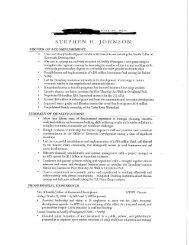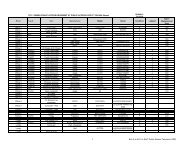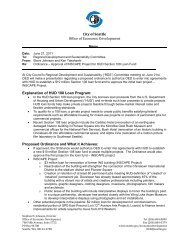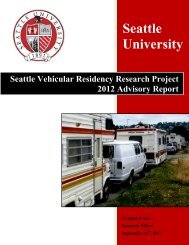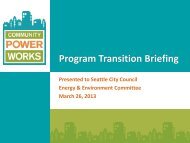2013 Water System Plan, Volume II - Seattle City Clerk's Office - City ...
2013 Water System Plan, Volume II - Seattle City Clerk's Office - City ...
2013 Water System Plan, Volume II - Seattle City Clerk's Office - City ...
You also want an ePaper? Increase the reach of your titles
YUMPU automatically turns print PDFs into web optimized ePapers that Google loves.
Chapter 5 <strong>Water</strong> Infrastructure<br />
Valve<br />
Combo Air Release/<br />
Air Vacuum<br />
Use in SPU <strong>Water</strong> <strong>System</strong><br />
Combination air release/air vacuum valves are air valves that have both large orifices and small<br />
orifices and provide the combined functions of both types of valves. These valves must comply<br />
with the requirements of ANSI / AWWA C512. They are sized per AWWA M51 based on 2-<br />
psi pressure differential for filling and draining. Air release valve orifice sizes are chosen based<br />
on water main operating pressure and air release rate, which must be selected to avoid abrupt<br />
pressure surges.<br />
Air vacuum and air release valves must be equipped with isolation valves and be installed in<br />
vaults. Discharge from all air valves must be plumbed to the surface. Washington State DOH<br />
regulations for cross connections do not allow discharge into the vault.<br />
On large pipelines, open air stand pipes are sometimes used in lieu of a combination valve.<br />
B. Bypass Requirements<br />
Bypass assemblies are used on larger valves to ease valve opening. When a line has<br />
been closed, and one side of the pipeline drained, pressure on the valve becomes<br />
unbalanced making it very difficult to open the valve. A bypass line allows water to<br />
backfill the unpressurized side of the valve, which equalizes pressure on the valve<br />
allowing it to open more easily. Bypass assemblies also allow the operator to fill an<br />
empty pipe more precisely. Bypass assemblies must be installed on all valves 16-inches<br />
and larger in diameter. A typical bypass assembly is included in the standard line valve<br />
vault detail. Typically, SPU will use a hydrant or an adjacent active line with a PRV and<br />
temporary piping to do this. See Figure 5-5 Typical Layout of a 16-inch or Larger Line<br />
Valve.<br />
C. Valve Turns<br />
The number of turns to close a valve is very important. Rapidly closing a valve can create<br />
a surge pressure wave in the pipeline and damage the line and appurtenances. See<br />
Standard Specification 9-30.3(4).<br />
D. Valve Spacing and Location<br />
Line valves are to be located at grid junctions in the distribution system, such that each<br />
of the converging main segments can be independently isolated. Additional<br />
intermediate valves may be required between grid connections, such that any single<br />
shutdown segment will be no more than one block (approximately 300 to 500 feet) in<br />
length within commercial/multi-family residence zones.<br />
On primary distribution mains and feeder mains larger than 12 inches in diameter,<br />
valves are to be located where these mains intersect with other mains larger than 12<br />
inches, such that each of the converging large diameter main segments can be<br />
independently isolated. Additional intermediate valves may be required between large<br />
diameter pipe junctions, such that any shutdown segment of a main larger than 12<br />
inches in diameter will be no more than 1,300 feet in length. The actual number and<br />
positioning of intermediate line valves on a main larger than 12 inches in diameter is to<br />
be guided by an analysis of secondary outage impacts associated with the isolation of<br />
individual segments of mains larger than 12 inches in diameter. As a general guideline,<br />
the total outage area resulting from the isolation of any one main segment including all<br />
of its subordinate dead-end systems (if any), should include no more than 130 accounts<br />
or 20 fire hydrants or 200 gpm of average daily consumption. Placement of line valves<br />
SPU Design Standards and Guidelines<br />
5-33



